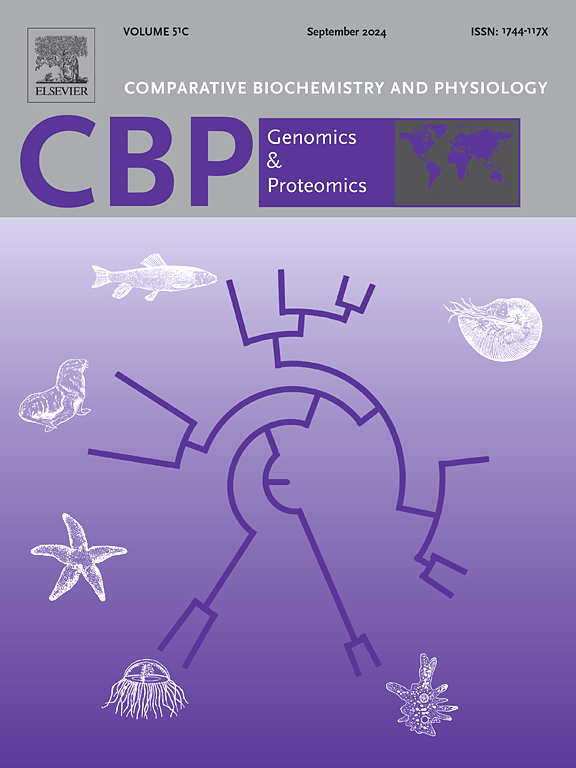Epigenetic regulation of physiological resilience to ammonia nitrogen stress in the Pacific whiteleg shrimp Penaeus vannamei: Evidence from genome-wide DNA methylation dynamics
IF 2.2
2区 生物学
Q4 BIOCHEMISTRY & MOLECULAR BIOLOGY
Comparative Biochemistry and Physiology D-Genomics & Proteomics
Pub Date : 2025-04-07
DOI:10.1016/j.cbd.2025.101510
引用次数: 0
Abstract
Although DNA methylation has emerged as an essential epigenetic mechanism modulating organismal responses to abiotic stresses, its involvement in the physiological resilience of marine invertebrates like shrimp to ammonia nitrogen toxicity remains enigmatic. Here, we performed the first comprehensive dissection of genome-wide DNA methylation dynamics in the Pacific whiteleg shrimp Penaeus vannamei exposed to ammonia nitrogen, based on whole-genome bisulfite sequencing and transcriptome analyses. In the genome of P. vannamei, three DNA methyltransferases (DNMT1, DNMT2 and DNMT3a), one DNA demethylase (TET2) and four methyl-CpG binding proteins (MBD2, MBD4, Kaiso, and UHRF1) were present. About 1.68–1.87 % of cytosine nucleotides were methylated, and higher percentages of cytosines in the CpG context (5.23 %–6.34 %) was methylated compared with the CHG and CHH contexts. Methylated cytosines were mostly enriched in the coding DNA sequence, and methylation peaks occurred near the transcription end sites. Following ammonia exposure, 4203 differentially expressed genes (DEGs) and 1100 differentially methylated genes (DMGs) were identified. The DMGs accounted for 4.4 % of the total gene reservoir in P. vannamei genome, and 212 shared genes were found between the DEGs and DMGs. Genes exhibiting significant methylation and expression changes were enriched in various pathways including the FoxO signaling pathway, autophagy and endocytosis. Among them was a group of genes related to energy metabolism, antioxidation response and detoxification metabolism, highlighting involvement of DNA methylation in fine-tuning these crucial physiological processes. These findings provide new insights into the regulatory roles of DNA methylation in the physiological resilience of marine invertebrates to aquatic stressors.

太平洋白对虾对氨氮胁迫生理恢复力的表观遗传调控:来自全基因组DNA甲基化动力学的证据
尽管DNA甲基化已成为调节生物体对非生物性胁迫反应的重要表观遗传机制,但它在虾等海洋无脊椎动物对氨氮毒性的生理恢复能力中的参与仍然是个谜。在这里,我们基于全基因组亚硫酸氢盐测序和转录组分析,首次全面剖析了暴露于氨氮的太平洋白对虾(Penaeus vannamei)的全基因组DNA甲基化动态。在凡纳滨对虾的基因组中,存在三种DNA甲基转移酶(DNMT1、DNMT2和DNMT3a)、一种DNA去甲基化酶(TET2)和四种甲基-CpG结合蛋白(MBD2、MBD4、Kaiso和UHRF1)。约有 1.68-1.87% 的胞嘧啶核苷酸被甲基化,与 CHG 和 CHH 上下文相比,CpG 上下文(5.23%-6.34%)中的胞嘧啶被甲基化的比例更高。甲基化的胞嘧啶主要富集在编码 DNA 序列中,甲基化峰出现在转录末端位点附近。氨暴露后,发现了4203个差异表达基因(DEG)和1100个差异甲基化基因(DMG)。DMGs占凡纳米鱼基因组总基因库的4.4%,在DEGs和DMGs之间发现了212个共享基因。表现出明显甲基化和表达变化的基因富集在各种通路中,包括 FoxO 信号通路、自噬和内吞。其中有一组基因与能量代谢、抗氧化反应和解毒代谢有关,这表明DNA甲基化参与了这些关键生理过程的微调。这些发现为DNA甲基化在海洋无脊椎动物对水生压力的生理恢复能力中的调控作用提供了新的见解。
本文章由计算机程序翻译,如有差异,请以英文原文为准。
求助全文
约1分钟内获得全文
求助全文
来源期刊
CiteScore
5.10
自引率
3.30%
发文量
69
审稿时长
33 days
期刊介绍:
Comparative Biochemistry & Physiology (CBP) publishes papers in comparative, environmental and evolutionary physiology.
Part D: Genomics and Proteomics (CBPD), focuses on “omics” approaches to physiology, including comparative and functional genomics, metagenomics, transcriptomics, proteomics, metabolomics, and lipidomics. Most studies employ “omics” and/or system biology to test specific hypotheses about molecular and biochemical mechanisms underlying physiological responses to the environment. We encourage papers that address fundamental questions in comparative physiology and biochemistry rather than studies with a focus that is purely technical, methodological or descriptive in nature.

 求助内容:
求助内容: 应助结果提醒方式:
应助结果提醒方式:


